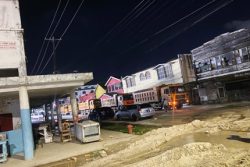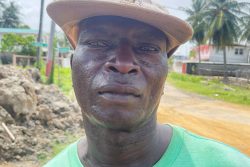DNA tests conducted on a strand of Sheema Mangar’s hair and a blood sample recovered from an impounded car did not yield a positive match and according to a source it is unkind for the police to keep this from relatives knowing full well that the case can go no further.
It was clarified to Stabroek News recently that the other samples sent to Barbados in August last year are not a critical component of the case as they were only sent for comparative purposes to confirm that they belonged to the dead woman.
The recent information obtained by this newspaper varies substantially from that given by the police in January this year in response to a Kaieteur News article. Manger’s parents who have been actively following the case have often accused the police of keeping them in the dark and dragging their feet.
The police had said that two cars suspected of being involved in the matter had been processed and items from the vehicles had been submitted to the Police Forensic Laboratory for analysis.
It was stated that during October 2010 the Officer in-charge of the Forensic Laboratory had been instructed to take the samples to the Barbados Police Forensic Laboratory for analysis which he did. While there officials of the Barbados Police Forensic Laboratory had indicated to him that they would complete the analysis by January 2011.
Those results came back in July last year, the police had said, while noting that they did not include the analysis of a hair sample which had been found on one of the vehicles. Enquiries revealed, they said, that it had not been submitted as it had been left behind. The sample was eventually dispatched to Bridgetown in August last year and the results were being awaited, police had said.
The source told this newspaper recently that investigators were urged to collect Mangar’s clothing for trace evidence purposes. However the only piece of clothing collected was her top, which was submitted to the Forensic Lab for analysis. It is unclear what happened to Mangar’s skirt and her undergarments.

Some time later the source said, police impounded two vehicles on one of which they found a strand of hair about half an inch in length which had no hair follicle, and on the other a piece of green cloth. Those were also submitted to the lab along with samples of a suspected bloodstain which was found on one of the cars.
The source pointed out that it was obvious that the piece of cloth was a different shade and fabric from that of Mangar’s top. “It look like two separate things. It is possible that it could have come from her but they (the police) did not collect all of her garments.”
It was noted that the strand of hair recovered was of little value because of the absence of the hair follicle which contains the cells needed for DNA testing. Further this newspaper was told that the technique to be used for testing this sample could not have been done in Barbados. The sample would have had to have been sent to a more advanced country like the USA for it to be compared with a sample of Mangar’s hair.
Based on the information Stabroek News obtained this was not a course that the Police Force would have pursued because it is very expensive to send samples to Barbados, much less the USA. The strand of hair had not been forgotten as is being claimed by the Force, the source said.
What was eventually sent to Barbados, this newspaper understands, was a sample of the bloodstain, a strand of hair that had been pulled from Mangar’s head and DNA samples submitted by her parents.
The source said that no time-frame was given by the Barbadian officials, but some time later preliminary results were sent. This newspaper was told that the results proved negative. It was explained that the samples from her parents and the strand of hair matched, but did not match the blood sample collected from one of the impounded cars.
“There was no forgetting,” the source said, adding that when it came to the two cars being impounded the investigators were “on a fishing expedition.” It was noted that police had nothing to show that either vehicle was involved in the killing.
Sloppy work
The source noted that the police should have paid careful attention to the scene, for example, getting a description of the perpetrator and the vehicle in which he fled. This, he continued, along with the physical evidence would have been used to build a case.
However investigators failed to do so, the source said, adding that the first few hours are the most critical in any investigation. If nothing much is done then, “you would be in trouble. It [the case] would become difficult to solve.”
“It was a sloppy investigation,” the source observed, before adding that it is now a cold case and the investigators “are doing nothing.”
Stabroek News was told that to this day there is still the belief that Mangar knew the man who snatched her phone. It was pointed out that the police “never went down that road” to prove or disprove the possibility.
Punishing
Meanwhile the source added that “they [the police] only punishing those people [the relatives]. They should come out and tell those people the truth. If they had done so they would have gotten closure a long time ago.”
Pointing out that not every case is solved, the source said that in this one, unless someone comes forward with information it is likely to go nowhere.
The police in their press release had expressed disappointment “at the continuing publication of inaccurate and misleading information concerning police-related issues by the Kaieteur News which can only be construed as aimed at sullying the image of the force.”
It was noted that the article accused the “Police Top Brass” of lying to the public, the media, and to Mangar’s family on the issue of the samples being taken to Barbados for analysis, when in fact the police officials had been truthful and correct.
Mangar’s mother Radica told Stabroek News recently that when she approached the police one day shy of the two year anniversary police had nothing new to tell her. She had said that all she knew was that a hair sample was in Barbados.
She said that she spoke to a senior officer who told her that investigators were awaiting the results of the sample sent to Barbados. He could give not give a reason for the delay or say when the results would be expected.
Mangar then a 20-year-old Demerara Bank employee was robbed of her mobile phone some time after 6 pm on September 11 as she waited for transportation on North Road, close to Camp Street.
The young woman chased the perpetrator, who jumped into a car and ran her down when she tried to stop him from fleeing. The woman was dragged from the Bedford Methodist Church at Camp Street and North Road to the intersection of Camp and Church streets. She died hours later at the St Joseph Mercy Hospital from a ruptured spleen, which was one of the many injuries she sustained.






